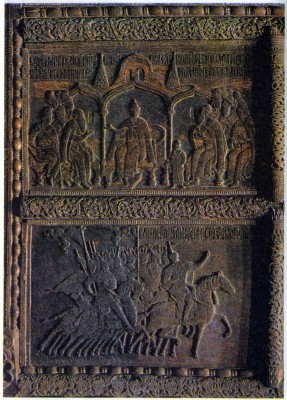The Epistle on the Monomachos Crown and The Tale of the Princes of Vladimir
The Epistle on the Monomachos Crown by Spiridon-Savva contains a legend that played a most important part in the development of the official ideology of the Russian autocratic state. It is the legend about the descent of the ruling dynasty of grand princes in Russia from the Roman emperor Augustus and the confirmation of its dynastic rights by the Monomachos crown, said to have been given to Prince Vladimir Monomachos of Kiev by the Emperor of Byzantium. This legend went back to the fifteenth century and may have been connected with the claims to the “emperor’s crown” made in the middle of that century by Grand Prince Boris of Tver. In 1498 Ivan Ill’s grandson Dmitry (who was descended from the princes of Tver on his mother’s side) was proclaimed co-ruler with his grandfather and crowned with the Monomachos cap. This was the first appearance of the crown which was subsequently used at the coronation of the rulers of Russia. Legends to substantiate this coronation may have existed even then, but the earliest written record of such legends that we know is Spiridon-Savva’s Epistle on the Monomachos Crown.

Relief carving on Ivan the Terrible’s throne in the Assumption Cathedral of the Moscow Kremlin depicting subjects from The Tale of the Princes of Vladimir 1551
A monk of Tver, who was appointed Metropolitan of All Russia in the fifteenth century in Constantinople and whom the Grand Prince of Moscow refused to recognise and subsequently imprisoned, Spiridon-Savva was a highly educated man for his day. He began his Epistle on the Monomachos Crown with an account of Old Testament history and the division of the universe under Augustus, in which the towns on the rivers Vistula and Neman were given to his kinsman Prus; one of Prus’ descendants was Rurik, who was thus “of the line of the Roman Emperor Augustus”. Then followed the legend about the summoning of the Varangians and an account of Vladimir Monomachos’ campaign against Constantinople and the presentation to him by the emperor of the Imperial crown that belonged to Augustus, and other gifts. This story is followed by an account of the lineage of the princes of Lithuania, who are said to be descended from the “slave-groom” Hegiminicus, who served Prince Alexander of Tver, the prince who restored the Russian lands after Batu’s invasion. Thus, the legend about the descent of the Russian rulers from the Emperor Augustus is connected here with Tver dynastic legends.
The Epistle on the Monomachos Crown provided the basis for one of the most popular sixteenth-century works, The Tale of the Princes of Vladimir.
For the most part its text was close to that of Spiridon’s Epistle, but the “Lineage of the Princes of Lithuania” was set apart in a special section and the role assigned by Spiridon to the princes of Tver was attributed to Prince Yuri of Moscow and his descendants; at the end there was a reference to Dmitry Donskoy’s victory over Mamai.
In 1547 an event of great importance for the history of the Russian state took place: the young Grand Prince Ivan IV was crowned with the Monomachos cap and proclaimed Tsar of All Russia. In this connection a special Coronation Order was compiled, the introduction to which made use of The Tale of the Princes of Vladimir.
The ideas of the Tale were expounded in diplomatic missives and are reflected in the chronicles, the sixteenth-century Book of Degrees and The Royal Genealogy. They even appeared in representational art: scenes from The Tale of the Princes of Vladimir are carved on the doors of the Royal Seat (the wooden partition for the throne of Ivan IV) in the Cathedral of the Assumption in Moscow.1
 History of Russian Literature
History of Russian Literature
